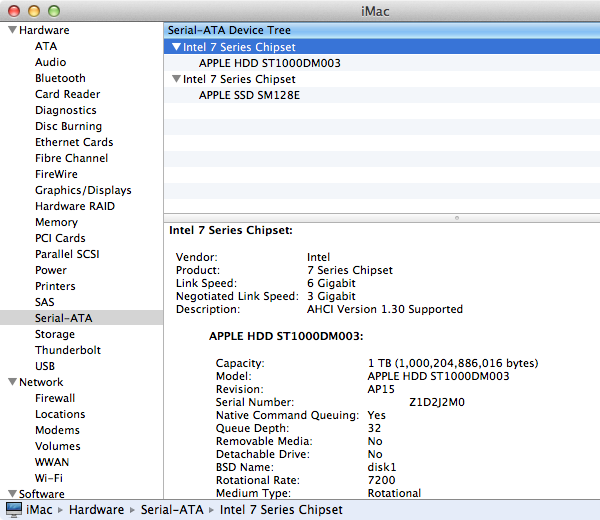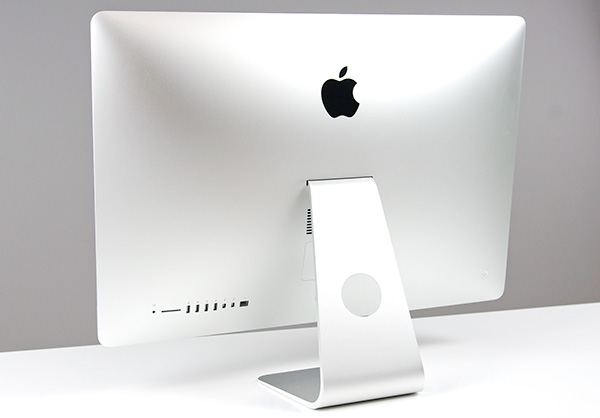A Month with Apple's Fusion Drive
by Anand Lal Shimpi on January 18, 2013 9:30 AM EST- Posted in
- Storage
- Mac
- SSDs
- Apple
- SSD Caching
- Fusion Drive
Meet Fusion Drive
Available as a build-to-order option on both the new Mac mini and the new iMac is Apple’s own take on SSD caching, Fusion Drive. In true Apple fashion there are only two Fusion Drive configurations available: 1TB and 3TB. The 1TB option is only available on the upgraded Mac mini ($799) or any of the iMacs, while the 3TB Fusion Drive is a 27-inch iMac exclusive.
In all of these cases, the Fusion Drive is a combination of a 1TB or 3TB hard drive (2.5” or 3.5”) and a 128GB Samsung PM830 based SSD. In the Mac minis this SSD is a 2.5” drive, while in the iMacs it’s the same custom interface that’s used in the MacBook Air and MacBook Pro with Retina Display. For my testing I used a 1TB Fusion Drive in a 27-inch iMac.
| Fusion Drive Options | |||||||
| Mac mini (2012) | Mac mini (2012) | Mac mini server (2012) | 21.5-inch iMac (2012) | 27-inch iMac (2012) | |||
| Base System Cost | $599 | $799 | $999 | $1299/$1499 | $1799/$1999 | ||
| 1TB Fusion Drive | - | +$250 | - | +$250 | +$250 | ||
| 3TB Fusion Drive | - | - | - | - | +$400 | ||
| Largest Standalone SSD | - |
256GB (+$300) |
2x256GB (+$600) |
- |
768GB (+$1300) |
||
The size of the SSD used in Apple’s Fusion Drive is much larger than what we usually find in a caching setup. Most OEMs ship with 8 - 24GB of NAND, and even then the drives rarely use a good controller. In the case of Apple’s Fusion Drive, Samsung’s PM830 continues to be one of the best combinations of performance and reliability we’ve ever tested. While I would’ve personally picked something like the Link A Media or Intel S3700 controller due to their excellent performance consistency, the PM830 is probably a more proven and/or affordable option for Apple.
Right off the bat Fusion Drive is different than most of the hybrid/caching solutions we’ve seen, but where it really diverges from the norm is in the software component. This isn’t simply Intel’s Smart Response Technology running under an Apple brand, instead we’re looking at virtualized storage courtesy of OS X’s Core Storage. First introduced in Lion, Core Storage is a logical volume manager that allows the OS to treat multiple physical disks as a single volume.
Apple originally used Core Storage to enable full disk encryption in Lion, but its use has been expanded to Fusion Drive in Mountain Lion. The creation of a Fusion Drive is simple. If you have multiple drives you can create a Fusion Drive yourself using some simple Terminal commands. When you buy a Fusion Drive equipped Mac, Apple does everything for you. Subsequent system and backup restores on your Mac with FD will maintain the Fusion Drive facade, even if you’ve purposefully destroyed the array.
Unlike traditional SSD caching architectures, Fusion Drive isn’t actually a cache. Instead, Fusion Drive will move data between the SSD and HDD (and vice versa) depending on access frequency and free space on the drives. The capacity of a single Fusion Drive is actually the sum of its parts. A 1TB Fusion Drive is actually 1TB + 128GB (or 3TB + 128GB for a 3TB FD).

The latest version of Disk Utility will present a Fusion Drive as a single drive, labeled Macintosh HD from the factory. Apple doesn’t attempt to hide the FD underpinnings however, looking at System Report or using a third party utility like iStat Menus you’ll get statistics on both drives:

If you’ll notice, the 128GB SSD is reported as having a 121.33GB capacity. Since OS X 10.6, Apple has reported capacities in base 10 but if you do the math based on the capacity in bytes you’ll get an idea of how much space is set aside as spare area:
| Apple Fusion Drive, SSD Spare Area | |||||
| Total NAND | Exposed Capacity | Spare Area | |||
| Apple Fusion Drive 128GB SSD | 128 GiB | 113 GiB | 15 GiB | ||
Approximately 11.7% of the 128GiB of NAND is set aside as spare area, which is no different than what you get with a 128GiB SSD in a standard Mac, but a bit higher than the usual 6.7% spare area you get with most of these drives. The added spare area will help improve performance consistency, but it’s still a bit shy of what I like to see on Samsung SSDs (~25%).
You can create Boot Camp or other additional partitions on a Fusion Drive, however these partitions will reside on the HDD portion exclusively.











127 Comments
View All Comments
edlee - Friday, January 18, 2013 - link
I get the cached solution for fusion. But I would rather just handle the usage myself and have os and applications on SSD and all media on a Raid array.SSD for life.
Death666Angel - Friday, January 18, 2013 - link
It looks better than I thought. I'm still not going to use it myself (Windows/Linux user here and I have no trouble managing more than one partition). But it seems better than the usual Windows caching solutions. Still, the non-technical people I know don't need more than a few hundred GB of space on their PC and no one has more than one HDD in their PC anyway. So the easiest way for them (which is what I always recommend) is to have a 256GB SSD and an external 1 to 3TB drive. All their work is on the SSD with daily/weekly backups and photos are on their external HDD (none of those people use the PC to view movies).tipoo - Friday, January 18, 2013 - link
If you write a huge file, it all gets written to the SSD up to 117GB. But that SSD is filled with other stuff. Won't it be limited by the speed it transfers the old things to the hard drive? How does that work if the files aren't mirrored?name99 - Friday, January 18, 2013 - link
Read the damn article before posting. ALL those questions are answered there.ltcommanderdata - Friday, January 18, 2013 - link
Apple still lists the 3TB Fusion drive as incompatible with Boot Camp "at this time". Presumably this is due to how Apple is doing the BIOS emulation with EFI 1.10 and running into the 2.2TB drive size limit. Have you heard any methods to get 3TB Fusion working with Boot Camp or heard whether Apple has a solution in the works?tipoo - Friday, January 18, 2013 - link
Just curious, I think that's how Readyboost worked. You would have a flash drive immediately start sending data slowly to your computer while the hard drive took its time to seek the larger chunks of data. So I wonder if there is a large queue of data for a Fusion drive to read, it will read from both drives concurrently?tipoo - Friday, January 18, 2013 - link
"In less than a year Apple could double the size of the NAND used in Fusion Drive at no real change to cost."But will they? If the iPods, iPhones, and iPad are any indication, they will more likely pocket the savings. Been a long time since a capacity doubling from them.
name99 - Friday, January 18, 2013 - link
Oh for fscks sake.The iPod nano1 came in sizes of 1, 2, 4GB
The 2nd gen came as 2, 4, 8GB.
3rd were 4, 8GB
4th was 4,8, 16GB.
All at essentially the same retail price.
Apple has showed consistent pattern (you also see it in the shuffle, or in iPod Touch), of doubling the storage until they hit a point which seems to cover almost everyone's needs. Then there is a year or two of stasis, then a new product category which requires more storage.
Next time you want to post blatant nonsense, try to remember that on the internet people WILL call you out when you state bullshit.
tipoo - Friday, January 18, 2013 - link
Feeling self-important today? Yes, that's what I mean, there hasn't been a doubling since the fourth generation Nano. Or does "Been a long time since a capacity doubling from them" mean "they have never ever doubled capacity" in your little world?tipoo - Friday, January 18, 2013 - link
"Then there is a year or two of stasis, then a new product category which requires more storage."Like the iPads, which would be ideal for storing HD video if not for the exorbitant prices of higher capacities, with zero bump for the base price since the first one?